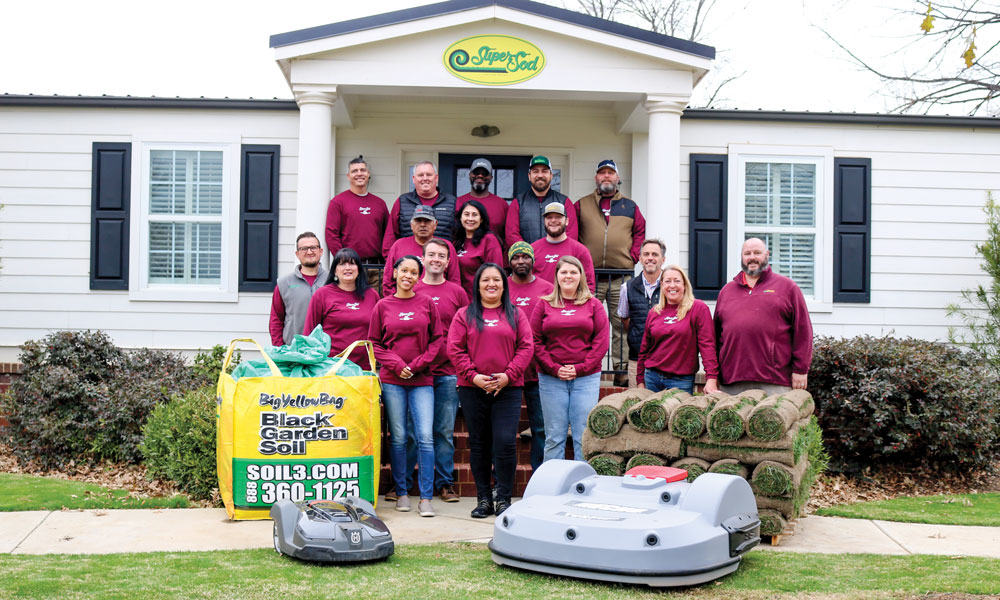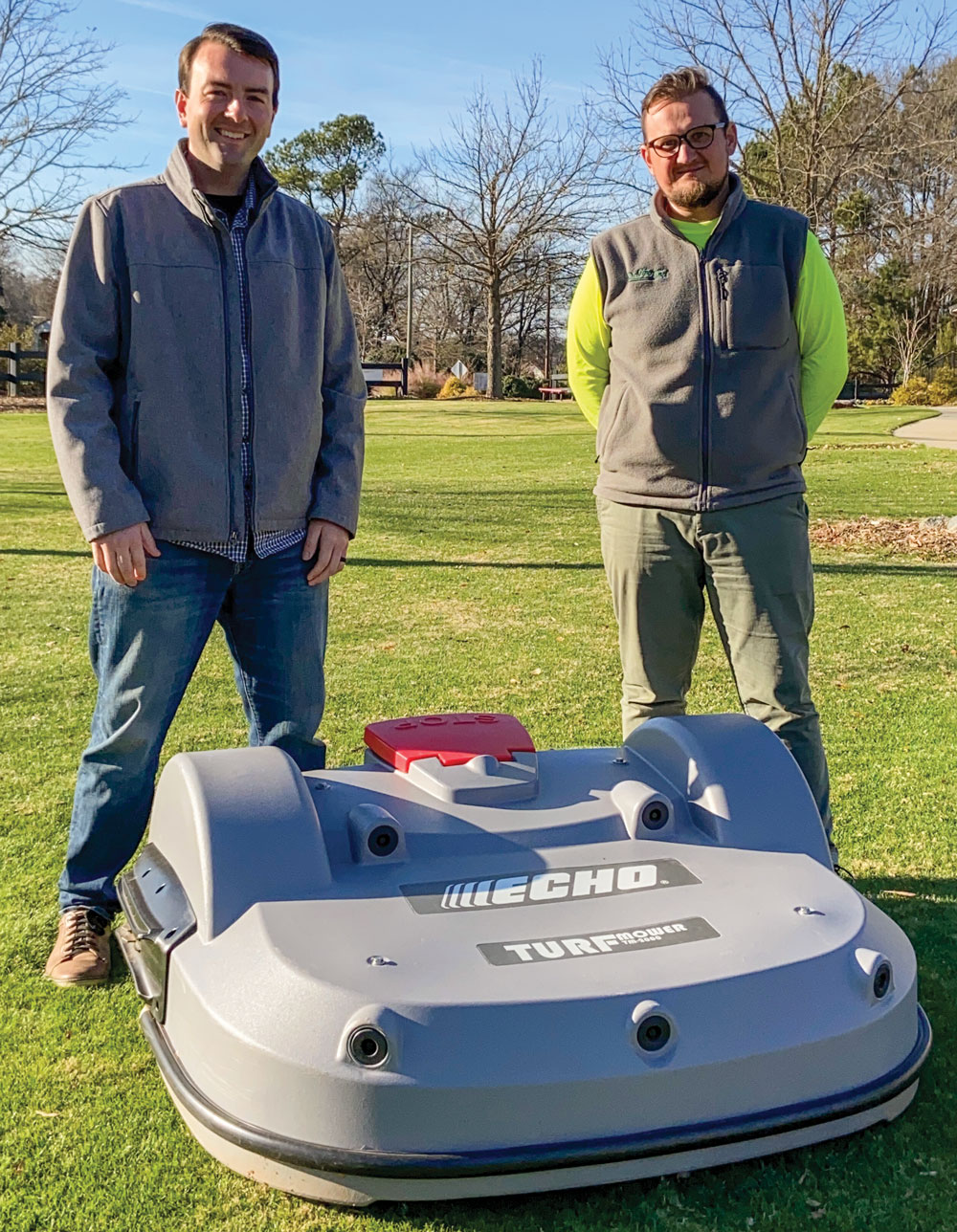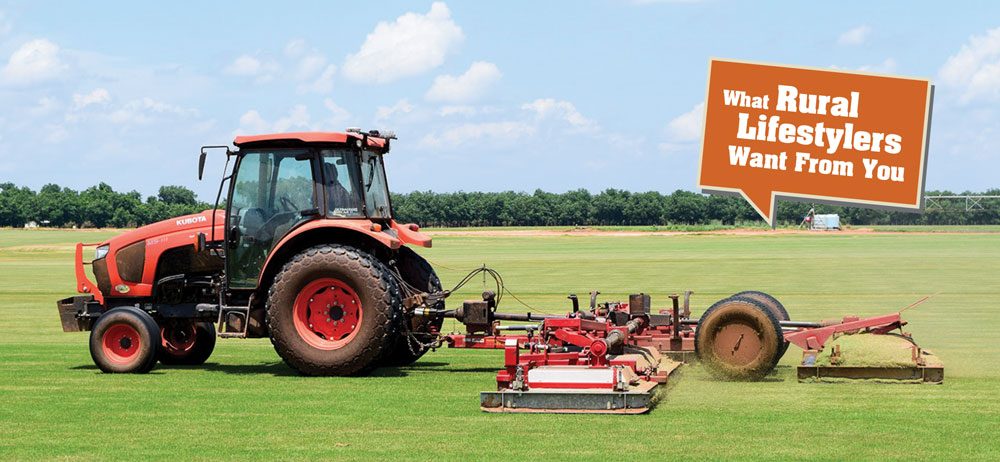Pictured Above: With 7 sod farms to maintain, Super-Sod has rather intensive equipment needs ranging from tractors and mowers to seeders, rollers, aerators and specialty implements. The company serves customers in Georgia and North and South Carolina. Photo Courtesy of Super-Sod
Super-Sod has spent decades establishing a reputation for innovative turf solutions. From unique seeds and sods to fertilizers and organic composts, the 5th generation company has always focused on helping its customers in Georgia and North and South Carolina maintain the highest quality of turfgrass possible.
Over the past couple of years, robotic mowers have proved to be Super-Sod’s latest advancement in turf innovation.
“Super-Sod’s entire existence has been based on providing exceptional turfgrass. Certain types of customers want a mower that provides the best cutting result they can get. That is where robotic mowers fit in. Our customers are a perfect match,” says Nick Sagnella, robotics division manager for Super-Sod.
Sagnella has only been with Super-Sod for a couple of years. His experience with turfgrass and robotic mowers, however, is rather extensive. Sagnella once owned a sod installation company in the Charlotte, N.C., market and was actually a Super-Sod customer. After selling that company, Sagnella took on a business partner and started a new company with the sole focus of providing automated home services, including lawn mowing. That venture was short-lived for a variety of reasons.
Dealer Takeaways
- Downtime is unacceptable to a sod farmer. Being on a first-name basis with reliable servicing dealers is a must.
- When looking to sell robotic mowers, dealers should identify customer segments that place a high value on perfectly manicured turf.
- Demonstration displays help pique a customer’s curiosity about robotic mowers — and then the education process can begin toward making a sale.
Nonetheless, Sagnella’s desire to help accelerate the proliferation of autonomous mowing in the Southeast remained strong. He is now fulfilling that desire as a key member of the Super-Sod team.
Maintaining Healthy Turf
Super-Sod has become one of the largest sod suppliers in the country. The company farms roughly 15,000 acres across its 7 farms in Georgia and North and South Carolina.
“We ship seed all over the country. Sod is a bit different though. Sod is highly perishable and costly to transport so we typically don’t ship our sod very long distances. Generally speaking, we limit it to around 200 miles from the farm it is shipping from,” says Preston Cavenaugh, Super-Sod’s regional director for central South Carolina and North Carolina.
Super-Sod grows 7 varieties of sod and is always pushing the envelope with respect to sustainability and innovation. For instance, “TifTuf has become the standard for hybrid bermudagrass; it is tough and uses a lot less water. Another example is Zeon Zoysia, a newer grass variety that has great tolerance to extreme heat and cold,” Cavenaugh says.

Super-Sod remains a family and employee-owned company with 7 sod farms and 13 stores across Georgia and North and South Carolina. Pictured here is the team from the company’s Charlotte, N.C., location, along with a sampling of the company’s unique product offering of seed, sod, soil and robotic mowers. The company employs 200-250 people across its footprint in the Southeast. Photo Courtesy of Super-Sod
Super-Sod’s seed business comprises 3 primary products: Centi-Seed, TifBlair (also sold as sod) and Zenith zoysia (also sold as sod). “We are the world’s largest producer of both Zenith and TifBlair seed,” Cavenaugh points out.
Super-Sod has long standing roots in not only seed and sod, but also fertilizer and soil amendments.
“A third key product line for us has been Soil3, an organic compost we make from grass clippings coming off of our farms. We also make it as a soil amendment that we sell to our sod customers and home gardeners. We’ve been making Soil3 for around 7 years. It is great — we actually use it ourselves on our farms,” Cavenaugh says.
With 15,000 acres to work on 7 farms in 3 states, Super-Sod has intensive equipment needs. Like any crop-farming operation of this size, Super-Sod has a fleet of tractors, John Deere and Kubota, to be precise. The equipment fleet also includes an assortment of implements such as rollers, discs, seeders, aerators and land planers.
“We also have many more mowers than the typical farmer. We use really large mowing implements to mow our production fields,” Cavenaugh says. Super-Sod’s mowing arsenal includes implements from FireFly, Progressive Turf Equipment and Trimax, each of which uses roller mower decks.
“Robotics is developing a lot faster than many people think…”
–Nick Sagnella of Super-Sod
Because Super-Sod’s production operation is so specialized, there is also a need for some specialty equipment such as sod harvesters.
“Sod harvesting technology has taken a giant leap in evolution over the past decade or so. The traditional sod harvester used to require 3 or 4 people to operate and costs around $50,000. Modern sod harvesters are robotic, require 1 person to operate, can do 5 times the production and cost around $400,000. We are constantly trying to take advantage of technology and find ways to be more efficient,” Cavenaugh says. Super-Sod’s sod harvesting equipment includes models from Trebro, FireFly, Brouwer and Magnum.
Regardless, if a piece of equipment is brand new or many years old, maintaining maximum uptime is crucial to Super-Sod’s operation.
“Our product (sod) requires a lot of time-sensitive care. Once we harvest it, sod is extremely perishable. We have 24-36 hours to get it to the customer. So we have a very thin margin for error when it comes to equipment breakdowns,” Cavenaugh says.
To successfully tread that thin margin, Super-Sod’s equipment managers count on two things: faithful in-house preventive maintenance and reliable dealer support.
“Most equipment maintenance is done in-house due to the size of our operation. We are lucky to have some great technicians. We also depend on outside vendors for both parts and service. Since we have farms spread out across 3 states, we use several dealerships depending on location. The two largest factors driving our decisions of what to use and whom to work with are reliability and parts availability. Clear avenues of communication with our dealers has been crucial. All of the key personnel at our farms are on a first-name basis with our servicing dealers.
At the same time, because a lot of our production and harvesting equipment is very specialized, we also need to maintain clear channels of communication with our OEMs,” Cavenaugh says.
Super-Sod also strives to maintain clear channels of communication with its customers — especially when it comes to education and new product innovations. Customer segments include homeowners, landscape contractors, builders, developers, municipalities, golf courses and athletic fields.
Cavenaugh says new product innovations are something the company is looking to exploit internally as well. “We (Super-Sod) are continually looking for ways to leverage new technologies to gain efficiencies. We’re looking for opportunities not only within our own production operation, but also in how our customers interact with our products in the marketplace. Robotics is playing a big role,” Cavenaugh says.
Robotics Enhance Management
As a sod installation contractor years ago, Sagnella says one of his biggest challenges was getting customers to institute a proper mowing regimen.
“Most people want to mow once a week, either out of convenience or budgetary constraints. But in most situations, especially here in the South, turfgrass needs to be mowed more often for the best appearance and health. Robotic mowers provide for that,” Sagnella says.

Nick Sagnella (left) is Super-Sod’s robotics division manager. On the right is Andrey Ryabyy, who handles installation and service operations for the robotics division. Photo Courtesy of Super-Sod
While some customers are not yet receptive to the idea of more frequent mowing, a growing number are. In fact, highly frequent mowing is in perfect alignment with some customers’ goals. So is the idea of autonomous mowing.
Sagnella thinks back to when he was first starting up that robotic home services company.
“When it became apparent that our target market wasn’t ready for this type of service yet, I decided to make a pivot. I had already been talking with Preston (Cavenaugh) when we were first getting into robotic mowers. I remember one phone call that turned a bit awkward. I’d asked Preston what he knew about robotic mowers. He paused for a second and said, ‘Uh, can I call you back?’ I didn’t realize it at the time, but Super-Sod was also looking to branch into selling robotic mowers.
“When I recognized that my startup idea was not going to work out the way I’d hoped, I called Preston back. I joined the company a couple of years ago and we’ve gained traction fast,” Sagnella says.
Super-Sod was already a Husqvarna Automower dealer prior to Sagnella joining the company.
“My task was to figure out the best way to bring the Husqvarna product to market,” Sagnella says. Over the past year, he has also had to figure out how best to bring the Echo autonomous mower to market. Super-Sod became an Echo Robotics dealer in early 2019.
The market for robotic mowing is still relatively early in its life cycle. Nonetheless, Sagnella says offering the two brands makes perfect sense as a dealer.
“The reason we sell both Husqvarna and Echo is that they do not conflict with each other. Husqvarna is the best in the market for complex landscape environments with a lot of beds, narrow corridors and obstacles.
“Echo, on the other hand, offers a much larger robotic mower model. Echo is better suited for big, open spaces with more even terrain,” Sagnella says.
Super-Sod has had success in selling these larger Echo robotic mowers to golf courses and sports fields. Sagnella says sports turf customers are already accustomed to mowing multiple times per week. Thus, a robotic mower makes perfect sense for them because it helps cut down on labor costs. The same can be said about golf courses.
Plus, Echo’s new RP-1200 Range Picker is a robotic golf ball-retrieving device. Working in tandem with an Echo robotic mower, golf courses can maintain perfectly manicured turf 24/7 because there is no longer a fear of mowing over golf balls.
Promoting Robotics to Homeowners
Super-Sod has also had success selling robotic mowers to DIY property owners. This is where the Husqvarna Automower comes into the conversation.
“There are many other markets we could go after that would benefit from robotic mowing. But right now, homeowners, golf courses and sports fields yield the best opportunity. So that’s what we are focused on — for now,” Sagnella says.
Super-Sod sells its robotic mowers directly to customers. All of Super-Sod’s retail locations now also feature outdoor demonstration displays of the Echo and Husqvarna robotic mowers.

Super-Sod’s store “showrooms” are primarily outdoor areas used to display not only the company’s sod and soil offerings, but also its robotic mowers. “We replicate a home landscape so customers can see first-hand how their lawn could look,” says Nick Sagnella, robotics division manager. Photo Courtesy of Super-Sod
“When a customer is in the process of choosing their turf, they can see firsthand how these robotic mowers work. Many customers ask what this is all about and then the education process can begin. For us, robotic mowers are woven into the process of buying a lawn,” Sagnella says.
When a customer does purchase a robotic mower, it is not as simple for the dealer as filling the mower with gas and sending the customer on their way. On-site installation is required, and not all customers are willing or able to handle it themselves.
“We always offer to take a look at the customer’s property. First, we make sure a robotic mower will be a good fit for that property. If it’s a good fit, we’ll offer to install all of the wiring and get the mower calibrated. Some customers choose to handle this on their own, but most don’t want to do that,” Sagnella says.
The process for Super-Sod’s golf course and sports field customers is similar. The difference is that these customers are not even given the option of setting up the system on their own.
“In these types of environments, there are more complexities to be taken into consideration,” Sagnella points out. Unlike the typical homeowner’s property, golf courses and sports fields must compensate for play schedules and pedestrian traffic.
Thus, there are more restrictions as to where and when a mower can go, as well as where it can go to dock and recharge. Additionally, mowing schedules must be balanced with irrigation and aeration schedules. To ensure a good experience for the customer, Super-Sod personnel like to be part of the setup process.
Once a robotic mowing system is up and running, Sagnella says customers have little to worry about.
“Our paradigm isn’t to try and provide equipment service at every opportunity. We just want customers to be happier with their turf. There are fewer opportunities for after-sale service and support with robotic mowers. That’s because there are no belts, oil, filters or carburetors. The only regular maintenance item is to replace the cutting blades every so often, which is simple for one person to do with a screwdriver.
“We also train customers to regularly clean and inspect their mower. Other than that, there really isn’t much to do,” Sagnella says.
Super-Sod’s robotics division has taken off quickly over the past couple of years. Of course, robotic mowing hasn’t caught on with every customer as of yet. But that could be changing as robotics continues to evolve and awareness expands.
“What the future of robotics holds still remains to be seen, but there is a lot brewing out there right now. Robotics is developing a lot faster than many people think, and it will likely look a bit different than what anybody is expecting,” Sagnella says.





Post a comment
Report Abusive Comment